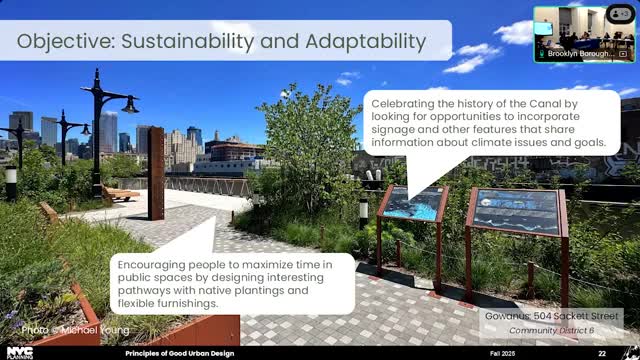Prospect Park Alliance wins borough board approval to restore Willink Restroom; project team says repairs are time‑sensitive
October 10, 2025 | Kings County - Brooklyn Borough, New York
This article was created by AI summarizing key points discussed. AI makes mistakes, so for full details and context, please refer to the video of the full meeting. Please report any errors so we can fix them. Report an error »

The Brooklyn Borough Board voted 21 in favor, 0 opposed and 1 abstention on Oct. 7 to approve the Prospect Park Alliance’s proposal to reconstruct and rehabilitate the Willink Restroom on the park’s east side.
David Yum, director of preservation and architecture for Prospect Park Alliance, and architect Rachel Pendleton presented the project during a public hearing. They described a plan to repair the roof and roof membrane, restore masonry and the building’s Guastavino tile interiors, upgrade mechanical systems and bring restroom access and stalls into current Americans with Disabilities Act (ADA) standards. Yum said the team has raised $2.8 million of the $4,000,000 estimated cost through allocations from Council districts representing the area.
Yum told the board the building, constructed in 1913, had a major reconstruction in the 1990s and is now showing renewed signs of moisture intrusion; he described terracotta roof tile as having an approximate useful life of about 30 years and said the project is “time‑sensitive” because prolonged moisture retention is starting to damage the roof and interior tile. The Alliance’s presentation included plans to install attic ventilation, replace deteriorated roof sheathing and membrane, reconstruct exterior doors and windows, improve lighting and security features and reconfigure interior stalls so the restroom meets ADA requirements.
The Prospect Park Alliance also said one side of the building will continue to be used for park staff operations — offices, storage and locker space — because there is no convenient nearby location for maintenance staff and equipment. The Alliance described the Guastavino tile as a key historic feature and said early intervention will avoid a much more expensive reconstruction or replication later.
Board members asked about projected useful life and maintenance; the project team said the renovated terracotta roof portion would be expected to last roughly 30 years, and that ongoing maintenance will be required. The Alliance said the city requires an open competitive bid process for construction and that the team develops independent cost estimates to compare with bids.
After the public hearing closed with no members of the public signed up to testify, the board proceeded to a roll‑call vote and approved the reconstruction project. The Alliance said it would proceed with design development and the necessary approvals from agencies including NYC Parks, the Department of Buildings and Landmark preservation review where applicable.
David Yum, director of preservation and architecture for Prospect Park Alliance, and architect Rachel Pendleton presented the project during a public hearing. They described a plan to repair the roof and roof membrane, restore masonry and the building’s Guastavino tile interiors, upgrade mechanical systems and bring restroom access and stalls into current Americans with Disabilities Act (ADA) standards. Yum said the team has raised $2.8 million of the $4,000,000 estimated cost through allocations from Council districts representing the area.
Yum told the board the building, constructed in 1913, had a major reconstruction in the 1990s and is now showing renewed signs of moisture intrusion; he described terracotta roof tile as having an approximate useful life of about 30 years and said the project is “time‑sensitive” because prolonged moisture retention is starting to damage the roof and interior tile. The Alliance’s presentation included plans to install attic ventilation, replace deteriorated roof sheathing and membrane, reconstruct exterior doors and windows, improve lighting and security features and reconfigure interior stalls so the restroom meets ADA requirements.
The Prospect Park Alliance also said one side of the building will continue to be used for park staff operations — offices, storage and locker space — because there is no convenient nearby location for maintenance staff and equipment. The Alliance described the Guastavino tile as a key historic feature and said early intervention will avoid a much more expensive reconstruction or replication later.
Board members asked about projected useful life and maintenance; the project team said the renovated terracotta roof portion would be expected to last roughly 30 years, and that ongoing maintenance will be required. The Alliance said the city requires an open competitive bid process for construction and that the team develops independent cost estimates to compare with bids.
After the public hearing closed with no members of the public signed up to testify, the board proceeded to a roll‑call vote and approved the reconstruction project. The Alliance said it would proceed with design development and the necessary approvals from agencies including NYC Parks, the Department of Buildings and Landmark preservation review where applicable.
View full meeting
This article is based on a recent meeting—watch the full video and explore the complete transcript for deeper insights into the discussion.
View full meeting
